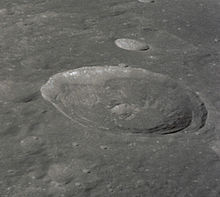Herschel (lunar crater)
 The lunar crater Herschel is in the centre of this image, with Ptolemaeus to its right. NASA photo. | |
| Diameter | 41 km |
|---|---|
| Depth | 3.8 km |
| Colongitude | 3° at sunrise |
| Eponym | William Herschel |


Herschel is a lunar impact crater located just to the north of the walled plain Ptolemaeus. Just to the north is the flooded crater Spörer, and due east lies the disintegrated crater Gyldén. About a crater diameter to the northwest is the walled plain Flammarion, along the southern edge of the Sinus Medii.
The rim of this crater is generally circular, although the western side is straight. It has a well-defined edge that is not significantly worn, and the inner walls are terraced. On the rough inner floor is a notable central rise. This peak is offset slightly to the west of the crater midpoint. The small crater Herschel G is attached to the south-southwest rim, and a tiny craterlet lies across the southern rim.
Satellite craters
By convention these features are identified on lunar maps by placing the letter on the side of the crater midpoint that is closest to Herschel.
| Herschel | Latitude | Longitude | Diameter |
|---|---|---|---|
| C | 5.0° S | 3.2° W | 10 km |
| D | 5.3° S | 4.0° W | 20 km |
| F | 5.8° S | 4.4° W | 7 km |
| G | 6.5° S | 2.4° W | 14 km |
| H | 6.3° S | 3.4° W | 5 km |
| J | 6.4° S | 4.3° W | 5 km |
| N | 5.2° S | 1.1° W | 15 km |
| X | 5.3° S | 2.7° W | 3 km |
See also
References
- Andersson, L. E.; Whitaker, E. A. (1982). NASA Catalogue of Lunar Nomenclature. NASA RP-1097.
{{cite book}}: Invalid|ref=harv(help) - Blue, Jennifer (July 25, 2007). "Gazetteer of Planetary Nomenclature". USGS. Retrieved 2007-08-05.
{{cite web}}: Invalid|ref=harv(help) - Bussey, B.; Spudis, P. (2004). The Clementine Atlas of the Moon. New York: Cambridge University Press. ISBN 978-0-521-81528-4.
{{cite book}}: Invalid|ref=harv(help) - Cocks, Elijah E.; Cocks, Josiah C. (1995). Who's Who on the Moon: A Biographical Dictionary of Lunar Nomenclature. Tudor Publishers. ISBN 978-0-936389-27-1.
{{cite book}}: Invalid|ref=harv(help) - McDowell, Jonathan (July 15, 2007). "Lunar Nomenclature". Jonathan's Space Report. Retrieved 2007-10-24.
{{cite web}}: Invalid|ref=harv(help) - Menzel, D. H.; Minnaert, M.; Levin, B.; Dollfus, A.; Bell, B. (1971). "Report on Lunar Nomenclature by the Working Group of Commission 17 of the IAU". Space Science Reviews. 12 (2): 136–186. Bibcode:1971SSRv...12..136M. doi:10.1007/BF00171763.
{{cite journal}}: Invalid|ref=harv(help) - Moore, Patrick (2001). On the Moon. Sterling Publishing Co. ISBN 978-0-304-35469-6.
{{cite book}}: Invalid|ref=harv(help) - Price, Fred W. (1988). The Moon Observer's Handbook. Cambridge University Press. ISBN 978-0-521-33500-3.
{{cite book}}: Invalid|ref=harv(help) - Rükl, Antonín (1990). Atlas of the Moon. Kalmbach Books. ISBN 978-0-913135-17-4.
{{cite book}}: Invalid|ref=harv(help) - Webb, Rev. T. W. (1962). Celestial Objects for Common Telescopes (6th revised ed.). Dover. ISBN 978-0-486-20917-3.
{{cite book}}: Invalid|ref=harv(help) - Whitaker, Ewen A. (1999). Mapping and Naming the Moon. Cambridge University Press. ISBN 978-0-521-62248-6.
{{cite book}}: Invalid|ref=harv(help) - Wlasuk, Peter T. (2000). Observing the Moon. Springer. ISBN 978-1-85233-193-1.
{{cite book}}: Invalid|ref=harv(help)
